In the modern era, technology is not just a tool; it is the very air that businesses breathe and the foundational infrastructure of our daily lives. At the heart of this digital revolution lies a term you hear everywhere: Information and Communication Technology (ICT).
But what exactly is ICT? It’s not just about a smartphone or a laptop. It is the vast, interconnected ecosystem that allows us to connect, share, learn, and grow, shaping everything from how a doctor diagnoses a patient to how a child learns math in a classroom.
This is a deep dive into the world of ICT, exploring its definition, its essential components, its profound human impact, and the exciting future it promises.
Table of Contents
What is ICT? A Human Definition
Information and Communication Technology (ICT) is an umbrella term that encompasses all applications, devices, networking components, and infrastructure that enable people and organizations to access, store, transmit, and manipulate information in a digital form.
Think of it this way:
- Information Technology (IT): Primarily focuses on the technology itself—the computers, software, and systems that process and store data. (The brain and the filing cabinet).
- Communication Technology (CT): Focuses on the tools that enable the transmission of that information—telephones, radio, television, and the internet. (The nerves and the voice).
- ICT: Is the powerful integration of both. It’s the entire system that allows you to click an email on your phone (IT), which is instantly sent across the globe (CT).
The Human Touch in ICT
At its core, ICT is fundamentally human. It has eliminated geographical barriers, allowing a grandparent in Dubai to see their grandchild’s first steps in London via a video call. It has democratized knowledge, putting the world’s libraries at the fingertips of a student in a remote village. ICT is not cold machinery; it is the engine of global human connection and productivity.
The Core Pillars: Major Components of ICT
ICT is not a single technology; it’s a harmonious system built upon several essential components that work in tandem.
| Component | Description | Examples |
| 1. Hardware | The physical and tangible devices that form the infrastructure. | Computers, Servers, Routers, Mobile Phones, Printers, Data Centers. |
| 2. Software | The intangible programs and applications that instruct the hardware on what to do. | Operating Systems (Windows, iOS), Application Software (Word, Photoshop), ERP Systems. |
| 3. Data & Information | The raw facts (data) and the processed, meaningful output (information) that the system stores, processes, and transmits. | Customer records, financial reports, sensor readings (IoT data), digital photos. |
| 4. Telecommunications | The technology that facilitates the transmission of data over distances. This is the ‘C’ in ICT. | Internet (Fiber Optics, Broadband), Mobile Networks (5G), Satellite Systems, VoIP (Voice over IP). |
| 5. Networking | The infrastructure that links hardware and software together to allow sharing of resources and data. | Local Area Networks (LAN), Wide Area Networks (WAN), Wi-Fi, Communication Protocols (TCP/IP). |
| 6. Procedures & People | The processes, policies, and, most critically, the individuals (users, administrators, developers) who design, manage, and use the system. | Cybersecurity policies, data entry protocols, IT support teams, end-users. |
The Revolution: ICT’s Role in Modern Life
The impact of ICT is so pervasive that it’s often invisible, yet it is responsible for the most profound shifts in how society operates.
3.1. Business & Commerce: Efficiency and Global Reach
For a business in the 21st century, ICT is the backbone that drives efficiency and competitive advantage.
- Operational Streamlining: ERP (Enterprise Resource Planning) systems and CRM (Customer Relationship Management) software, enabled by ICT, automate routine tasks, manage inventory in real-time, and eliminate manual errors. This frees up human talent to focus on creativity and strategy.
- E-Commerce Transformation: ICT enables e-commerce, transforming local shops into global marketplaces. Digital payments, secure transaction processing, and sophisticated logistics management systems (all ICT components) allow businesses to serve customers worldwide 24/7.
- Data-Driven Decisions: Every click, purchase, and interaction generates data. ICT tools like Big Data analytics and Business Intelligence (BI) convert this raw data into actionable insights, helping leaders forecast market trends and tailor products with incredible precision.
3.2. Education & Learning: Knowledge Democratized
ICT has shattered the traditional walls of the classroom, making education borderless and personalized.
- Distance Learning: Platforms like Coursera and Khan Academy, and simple tools like Zoom, have made high-quality education accessible to millions. This is crucial for lifelong learning and professional upskilling.
- Interactive Learning: Digital whiteboards, educational apps, and virtual reality (VR) simulations create engaging, immersive learning environments. A student can explore the human heart or ancient Rome without ever leaving their desk.
- Administrative Efficiency: ICT helps schools and universities manage student records, track performance, and automate grading, allowing educators to dedicate more time to teaching and mentoring.
3.3. Healthcare & Well-being: Precision and Access
ICT is transforming healthcare from reactive treatment to proactive wellness.
- Telemedicine: This has become a lifesaver, especially in remote areas, allowing patients to consult with specialists hundreds of miles away via video conferencing.
- Electronic Health Records (EHR): These digital records ensure patient data is secure, easily accessible by authorized medical staff, and reduces the risk of medical errors caused by illegible handwriting or lost files.
- Wearable Technology: Smartwatches and health trackers collect vast amounts of data on heart rate, sleep patterns, and activity. This IoT-driven data is managed by ICT systems and helps individuals and doctors monitor chronic conditions in real-time.
3.4. Governance & Society: Smart Cities and Transparency
ICT enables governments to be more efficient, transparent, and responsive to citizen needs.
- E-Governance: Services like online tax filing, digital identity cards, and public service portals simplify bureaucratic processes, reducing lines and waiting times.
- Smart Cities: In cities like Dubai, ICT powers smart streetlights, integrated public transport systems, and real-time traffic management, making urban life safer and more efficient.
- Global Communication: ICT is the foundation for social media, allowing for rapid communication, disaster response coordination, and the ability for citizens to organize and engage in democratic processes globally.
The Double-Edged Sword: Pros and Cons of ICT
Like any powerful force, ICT comes with both immense benefits and significant challenges that must be addressed with human wisdom.
| Area | Pros (The Benefit) | Cons (The Challenge) |
| Productivity | Automation of tasks leads to massive boosts in efficiency and output. | Over-reliance can lead to system-wide failure if core infrastructure breaks down. |
| Communication | Instantaneous global communication via email, video, and chat. | Information overload, constant digital distraction, and blurring of work-life boundaries. |
| Social Equity | Democratizes access to knowledge and education worldwide. | Creates the Digital Divide, where those without access to technology and skills are left behind. |
| Security | Advanced encryption and security protocols protect sensitive data. | Constant threat of cyberattacks, data breaches, and privacy violations (phishing, malware). |
| Jobs | Creates entirely new high-paying career paths (Data Scientists, Cybersecurity Experts). | Automation replaces jobs in traditional sectors, requiring massive reskilling efforts. |
Looking Ahead: Future Trends Shaping ICT
The evolution of ICT is accelerating, promising a future that is even more connected, intelligent, and autonomous.
| Trend | Description | Impact on the Future |
| Artificial Intelligence (AI) & ML | Integrating learning algorithms into every software and application to automate complex decision-making and personalize experiences. | AI will become embedded in business processes, transforming customer service (GenAI chatbots) and driving scientific discovery. |
| Internet of Things (IoT) & 5G | The vast network of interconnected physical devices (sensors, appliances, vehicles) communicating via the high-speed, low-latency 5G network. | Enables true Smart Cities, remote robotic surgery, and fully autonomous vehicles by facilitating real-time data exchange. |
| Edge Computing | Processing data near the source of its creation (the “edge” of the network) rather than relying solely on distant cloud data centers. | Critical for applications requiring instantaneous response times (like self-driving cars and factory automation), improving speed and security. |
| Quantum Computing | A revolutionary form of computing that uses quantum mechanics to solve problems currently impossible for traditional computers. | Could break current encryption methods but also lead to breakthroughs in medicine, materials science, and financial modeling. |
| Cybersecurity Resilience | Moving beyond basic prevention to building systems that can rapidly detect, withstand, and recover from sophisticated attacks. | Cybersecurity becomes a central design principle, moving from a reactive fix to a proactive foundation of all ICT systems. |
Frequently Asked Questions (FAQ)
Q1: Is ICT the same as IT?
A: No, but they are closely related. IT (Information Technology) focuses mainly on computer systems, software, and data management. ICT (Information and Communication Technology) is a broader term that encompasses IT and explicitly includes communication technologies like telecommunications, the internet, and wireless networks. Simply put, IT is a subset of ICT.
Q2: Why is ICT so important for developing countries?
A: ICT is a powerful catalyst for development. It improves access to vital services like e-learning (reducing the need for physical schools), telemedicine (connecting remote areas to doctors), and mobile banking (boosting financial inclusion for the unbanked). It helps countries leapfrog traditional infrastructure stages.
Q3: What is the “Digital Divide” and how does it relate to ICT?
A: The Digital Divide refers to the growing gap between those who have access to information and communication technology (and the skills to use it) and those who do not. While ICT connects the world, the Divide highlights the societal and economic inequalities that result from unequal access, often based on geography, income, or education level.
Q4: What are some examples of ICT in daily life?
A: ICT is everywhere!
- Personal: Sending an email, streaming a video, paying with a mobile app, using GPS navigation.
- Business: Using a video conferencing tool for a meeting, a cashier scanning a barcode at a grocery store, or checking a stock price on your phone.
Q5: What job roles are related to the ICT field?
A: The ICT field is massive and growing. Roles include:
- Software Developers
- Network Architects
- Cybersecurity Analysts
- Data Scientists
- Cloud Engineers
- IT Managers and Administrators
- Telecommunications Engineers



